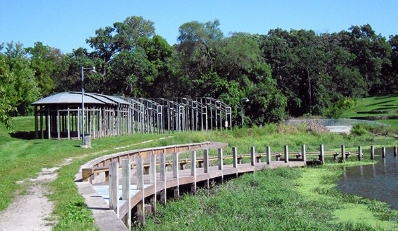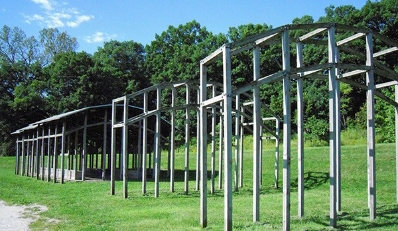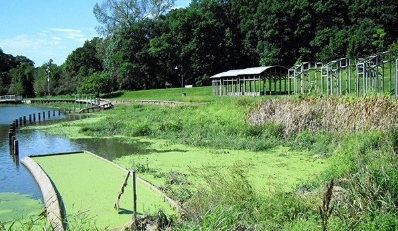About Greenwood Pond: Double Site
“Commissioned by the Des Moines Art Center, this 6.5-acre urban prairie and wetland ecosystem is one of a series of sculptural installations in the 147-acre picturesque Greenwood Park. From 1989-1996, environmental artist Mary Miss collaborated with various local groups to create an “outdoor classroom” oriented around a pond. A multi-level path system and a series of structures comprised of wood, steel, cement, and granite provide visitors diverse opportunities to interact with the site.
Three interconnected paths allow visitors to explore the installation, which also provides wildlife habitat and stormwater mitigation. Structures and smaller scale landscape features are distributed around the perimeter of the pond include a large covered pavilion and seating area, an arched wooden trellis, a small bridge pavilion, and a stepped stone terrace integrated with its natural surroundings. The pavilion, built into the side of a curving earthen mound, dissipates into a series of wooden archways while the bridge pavilion descends into a marsh of water lilies. The stone terrace traverses a hillside planted with native prairie grasses.
A gravel path and elevated wooden boardwalk create a continuous arc overhanging the edge of the pond. To the south, a ramp brings visitors down to the level of the pond before disappearing into the water. On the north side, the path transitions to a concrete-lined trough cut into the water, permitting visitors to descend until they are at eye level with its surface. The two sides of the path are visually connected across the pond by a long arc marked with wood pilings.”
– The Cultural Landscape Foundation
Historical Photos
Greenwood Pond: Double Site, Des Moines, IA - Photo copyright Judith Eastburn, 2014
.jpg)



A Note from artist, Mary Miss, on the demolition of Greenwood Pond: Double Site
Youtube, videos courtesy of The Cultural Landscape Foundation.
I believe that today, as the multiple questions surrounding climate change overwhelm us, this project is more important than ever. It gives people a chance to directly get a sense of the this important aspect of the Iowa landscape, its wetlands. Also, it puts the museum in a leadership role as a cultural institution helping to address the complex issues of our times. It features the role of women artists in giving a more intimate sense of our relationship to the land. And it shows that artists don’t always have to be kept offside—they can have an essential role in our public realm along with educators, scientists and policy makers in taking on these problems.
© 2024, All rights reserved. Website Design by and for the community | Privacy Policy